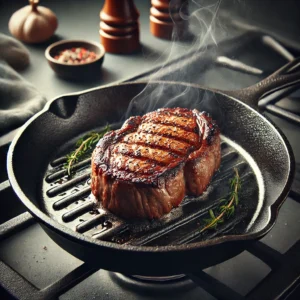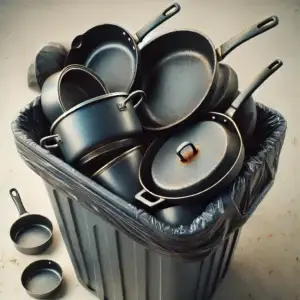We independently research and gather customer feedback on everything we recommend. When you buy through our links, we may earn a commission. Learn more >
Key Differences Between Cast Iron and Stainless Steel/ Cleaning & Maintance
Cast iron or stainless steel, you’re investing in durability, chemical-free cooking, and a more sustainable future. When it comes to choosing the best cookware for your kitchen, cast iron and stainless steel are two of the most popular options. Each has its own advantages, cooking properties, and best-use scenarios. But which one is right for you? In this guide, we’ll break down the key differences between cast iron and stainless steel cookware, how they cook differently, what foods work best with each, and how to properly care for them.
| Feature | Cast Iron | Stainless Steel |
|---|---|---|
| Heat Retention | Excellent, retains heat for a long time | Good, but loses heat faster |
| Heat Distribution | Uneven (hot spots possible) | Even heat distribution |
| Non-Stick Ability | Naturally non-stick when seasoned properly | Requires oil or butter to prevent sticking |
| Durability | Extremely durable, can last generations | Highly durable, resistant to rust and corrosion |
| Maintenance | Requires seasoning and careful cleaning | Low maintenance, easy to clean |
| Best for | Searing, frying, baking, slow cooking | Sautéing, boiling, making delicate sauces |
| Not Ideal for | Acidic foods (can strip seasoning) | High-heat searing (without oil) |
How They Cook Differently
Cast Iron retains heat exceptionally well, making it ideal for searing meats, deep frying, and baking. It takes longer to heat up but maintains a consistent temperature.

Stainless Steel heats up more quickly and distributes heat evenly, making it perfect for stir-frying, sautéing, and cooking delicate foods like fish or eggs.

Best Foods for Each Cookware
🥩 Best for Cast Iron:
Steaks and burgers (perfect sear and crust) [Follow our Guide to cook a perfect steak]
Cornbread and baked dishes
Fried chicken and potatoes
Braised meats (slow cooking)
Best for Stainless Steel:
Sautéed vegetables
Chicken breasts and seafood
Pasta sauces and soups
Scrambled eggs (with enough butter or oil)
What Not to Cook in Each
🚫 Avoid in Cast Iron:
Acidic foods like tomatoes and citrus-based sauces (can strip seasoning)
Delicate fish (can stick easily)
🚫 Avoid in Stainless Steel:
Sticky foods without oil (e.g., eggs, pancakes)
Cooking at extremely high temperatures without oil (can cause sticking and discoloration)


Cleaning & Maintenance
How to Properly Season a Cast Iron Skillet
Seasoning your cast iron is essential to maintain its non-stick properties and protect it from rust. Follow these steps to season your skillet properly:
Preheat Your Oven – Set it to 450°F (232°C).
Clean the Skillet – Wash your cast iron with warm water and mild soap (this is the only time soap is okay to use).
Dry Completely – Use a towel to remove all moisture, then place it on low heat for a few minutes to ensure it’s fully dry.
Apply a Thin Layer of Oil – Use a high-smoke-point oil like flaxseed, canola, or vegetable oil, rubbing a thin, even layer over the entire skillet (inside and outside).
Buff the Surface – Wipe off excess oil with a paper towel; it should not feel sticky.
Bake Upside Down – Place the skillet upside down on the oven rack with a baking sheet below to catch drips. Bake for 1 hour.
Let It Cool – Turn off the oven and allow the skillet to cool inside before removing it.
Repeat this process every few months or as needed to maintain a good seasoning layer.
🧼 Cleaning Cast Iron:
Wash with warm water and a soft sponge (avoid soap if possible).
Dry immediately to prevent rust.
Apply a light coat of oil to maintain seasoning.
Store in a dry place.
🧼 Cleaning Stainless Steel:
Wash with warm soapy water and a non-abrasive sponge.
Use baking soda or vinegar for stubborn stains.
Dry immediately to prevent water spots.
Store in a dry cabinet.
Which One Should You Choose?
Choose Cast Iron if you love high-heat cooking, searing meats, and slow-cooked meals. It’s a classic, long-lasting choice that adds flavor to your food over time.
Choose Stainless Steel if you need versatility, quick heating, and easy maintenance. It’s great for sautéing, making sauces, and everyday cooking.
Both types of cookware have their strengths, and many home chefs find it useful to own both for different cooking tasks.
Traditional Cookware is Bad for You and the Environment

Many conventional non-stick pans and aluminum cookware contain harmful chemicals that can negatively impact your health and the planet. Here’s why switching to cast iron or stainless steel is a smarter choice:
Toxic Chemicals in Non-Stick Coatings – Many non-stick pans use PTFE (Teflon) and PFOA, which release harmful fumes when overheated. These chemicals have been linked to various health issues, including hormone disruption and potential carcinogenic effects.
Aluminum Exposure Risks – Some aluminum cookware can leach metal into food, which may pose neurological risks with prolonged exposure.
Plastic Waste & Pollution – Cheap non-stick cookware has a short lifespan and often ends up in landfills, contributing to waste and environmental degradation.
Unstable Coatings – Many traditional pots and pans degrade quickly, releasing microplastics and toxins into your food and waterways.
Global Green Goods is a participant in the Amazon Services LLC Associates Program, an affiliate advertising program designed to provide a means for sites to earn advertising fees by linking to Amazon.com and affiliated sites. This means that when you click on certain links and make a purchase, we may earn a small commission at no extra cost to you.
We only recommend products that align with our commitment to sustainability, eco-friendliness, and quality. Your support helps us continue to create valuable content and promote environmentally responsible choices.
Thank you for supporting Global Green Goods!

Comments are closed.